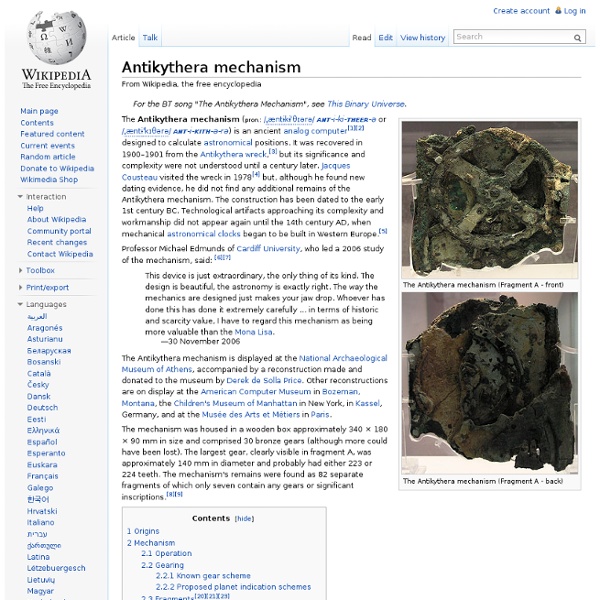Astrolabe
Astrolabe quadrant, England, 1388 A 16th-century astrolabe, showing a tulip rete and rule An astrolabe (Greek: ἀστρολάβος astrolabos, "star-taker")[1] is an elaborate inclinometer, historically used by astronomers, navigators, and astrologers. Its many uses include locating and predicting the positions of the Sun, Moon, planets, and stars, determining local time given local latitude and vice-versa, surveying, triangulation, and to cast horoscopes.
NASA: Discovery opens door to search for new life forms
News December 2, 2010 03:58 PM ET Computerworld - NASA scientists have found a new form of bacteria that they say has changed their notion of life as we've known it. Researchers said during a press conference Thursday that they found a strange microbe in Mono Lake in Northern California.
Tami Cowden
The TYRANT: the bullying despot, he wants power at any price. He ruthlessly conquers all he surveys, crushing his enemies beneath his feet. People are but pawns to him, and he holds all the power pieces. Hesitate before getting in this man’s way – he’ll think nothing of destroying you. The BASTARD: the dispossessed son, he burns with resentment.
More data storage? Here's how to fit 1,000 terabytes on a DVD
We live in a world where digital information is exploding. Some 90% of the world’s data was generated in the past two years. The obvious question is: how can we store it all? In Nature Communications today, we, along with Richard Evans from CSIRO, show how we developed a new technique to enable the data capacity of a single DVD to increase from 4.7 gigabytes up to one petabyte (1,000 terabytes). This is equivalent of 10.6 years of compressed high-definition video or 50,000 full high-definition movies.
Qumran
1. The Identity of the Qumran Community 1.1. Probable Identification of the Inhabitants of the Qumran Settlement with the Essenes 1.1.1. Pliny the Elder 1.1.2. Dio of Prusa 1.1.3. Epiphanius 1.2.
In New Quantum Experiment, Effect Happens Before Cause
September 19, 2013 - A real-world demonstration of a thought experiment conducted at the University of Vienna, has produced a result that is somewhat befuddling to people with what the lead researcher calls a "naïve classical world view." Two pairs of particles are either quantum-entangled or not. One person makes the decision as to whether to entangle them or not, and another pair of people measure the particles to see whether they're entangled or not. The head-scratcher is: the measurement is made before the decision is made, and it is accurate. "Classical correlations can be decided after they are measured," says Xiao-song Ma, the writer of the study.
Damascus Document
The Damascus Document Scroll, 4Q271Df, found in Cave 4 at Qumran The Damascus Document (CD) (the Cairo Damascus document) or Damascus Rule is one of the most interesting texts of the Dead Sea Scrolls because it is the only Qumran sectarian work that was known before the discovery of the Dead Sea Scrolls. It is a composite text edited together from different sections of a larger source, and scholars have attempted to place the different sections in a chronological order to generate a more complete work of the original using evidence from the Dead Sea Scrolls.[1] There were a number of fragments from the scroll found in the Cairo Geniza before the Qumran discoveries. The Cairo Geniza was located in a room adjoining The Ben Ezra Synagogue in Old Cairo, which was gradually stuffed full of papers until it was discovered by European scholar Dr Solomon Schechter in 1897. He found over 190,000 manuscripts and fragments that were written in mainly Hebrew and Judaeo-Arabic. [2]
Literal Smart Dust Opens Brain-Computer Pathway to “Spy on Your Brain”
Source: Activist Post Some might have heard about Smart Dust; nanoparticles that can be employed as sensor networks for a rangeof security and environmental applications. Now, however, literal Smart Dust for the brain is being proposed as the next step toward establishing a brain-computer interface. The system is officially called “neural dust” and works to “monitor the brain from the inside.”
4 Elements of Epic Storytelling
When I’m immersed in fantasy, a trance envelopes me. There’s something about great fantasy storytelling that trumps all other genres in drawing me into the world and story. Call me crazy, but I think I’m onto something here. And that something is the recipe for the domination of the imagination. Much like The Hero with a Thousand Faces, I think epic storytelling has a certain formula that can produce a killer product. What is it that makes your heart plummet when the screen goes black after Master Chief detonates the nuke at the end of Halo 4?



